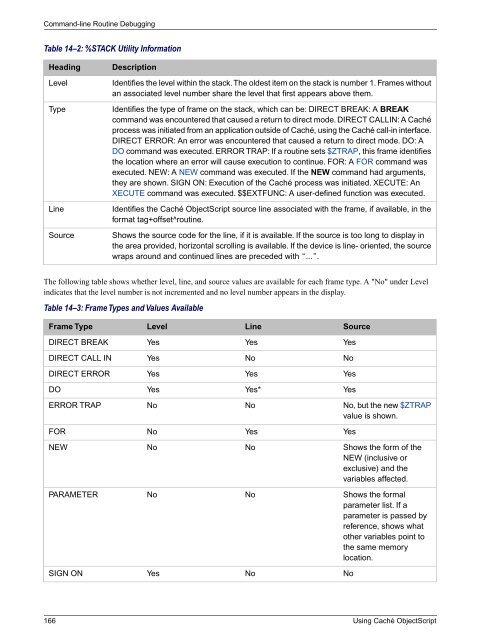Using Caché ObjectScript - InterSystems Documentation
Using Caché ObjectScript - InterSystems Documentation
Using Caché ObjectScript - InterSystems Documentation
Create successful ePaper yourself
Turn your PDF publications into a flip-book with our unique Google optimized e-Paper software.
Command-line Routine Debugging<br />
Table 14–2: %STACK Utility Information<br />
Heading<br />
Level<br />
Type<br />
Line<br />
Source<br />
Description<br />
Identifies the level within the stack.The oldest item on the stack is number 1. Frames without<br />
an associated level number share the level that first appears above them.<br />
Identifies the type of frame on the stack, which can be: DIRECT BREAK: A BREAK<br />
command was encountered that caused a return to direct mode. DIRECT CALLIN: A <strong>Caché</strong><br />
process was initiated from an application outside of <strong>Caché</strong>, using the <strong>Caché</strong> call-in interface.<br />
DIRECT ERROR: An error was encountered that caused a return to direct mode. DO: A<br />
DO command was executed. ERROR TRAP: If a routine sets $ZTRAP, this frame identifies<br />
the location where an error will cause execution to continue. FOR: A FOR command was<br />
executed. NEW: A NEW command was executed. If the NEW command had arguments,<br />
they are shown. SIGN ON: Execution of the <strong>Caché</strong> process was initiated. XECUTE: An<br />
XECUTE command was executed. $$EXTFUNC: A user-defined function was executed.<br />
Identifies the <strong>Caché</strong> <strong>ObjectScript</strong> source line associated with the frame, if available, in the<br />
format tag+offset^routine.<br />
Shows the source code for the line, if it is available. If the source is too long to display in<br />
the area provided, horizontal scrolling is available. If the device is line- oriented, the source<br />
wraps around and continued lines are preceded with “...”.<br />
The following table shows whether level, line, and source values are available for each frame type. A "No" under Level<br />
indicates that the level number is not incremented and no level number appears in the display.<br />
Table 14–3: Frame Types and Values Available<br />
Frame Type<br />
Level<br />
Line<br />
Source<br />
DIRECT BREAK<br />
Yes<br />
Yes<br />
Yes<br />
DIRECT CALL IN<br />
Yes<br />
No<br />
No<br />
DIRECT ERROR<br />
Yes<br />
Yes<br />
Yes<br />
DO<br />
Yes<br />
Yes*<br />
Yes<br />
ERROR TRAP<br />
No<br />
No<br />
No, but the new $ZTRAP<br />
value is shown.<br />
FOR<br />
No<br />
Yes<br />
Yes<br />
NEW<br />
No<br />
No<br />
Shows the form of the<br />
NEW (inclusive or<br />
exclusive) and the<br />
variables affected.<br />
PARAMETER<br />
No<br />
No<br />
Shows the formal<br />
parameter list. If a<br />
parameter is passed by<br />
reference, shows what<br />
other variables point to<br />
the same memory<br />
location.<br />
SIGN ON<br />
Yes<br />
No<br />
No<br />
166 <strong>Using</strong> <strong>Caché</strong> <strong>ObjectScript</strong>

















